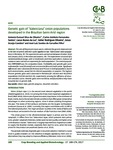Use este identificador para citar ou linkar para este item:
http://www.alice.cnptia.embrapa.br/alice/handle/doc/1068279Registro completo de metadados
| Campo DC | Valor | Idioma |
|---|---|---|
| dc.contributor.author | OLIVEIRA, A. E. S. de | pt_BR |
| dc.contributor.author | SANTOS, C. A. F. | pt_BR |
| dc.contributor.author | LUZ, L. N. da | pt_BR |
| dc.contributor.author | OLIVEIRA, V. R. | pt_BR |
| dc.contributor.author | CANDEIA, J. A. | pt_BR |
| dc.contributor.author | CARVALHO FILHO, J. L. S. de | pt_BR |
| dc.date.accessioned | 2017-04-10T11:11:11Z | pt_BR |
| dc.date.available | 2017-04-10T11:11:11Z | pt_BR |
| dc.date.created | 2017-04-10 | pt_BR |
| dc.date.issued | 2017 | pt_BR |
| dc.identifier.citation | Crop Breeding and Applied Biotechnology, v. 17, n. 2, p. 168-174, 2017. | pt_BR |
| dc.identifier.uri | http://www.alice.cnptia.embrapa.br/alice/handle/doc/1068279 | pt_BR |
| dc.description | The aim of the present study was to estimate the genetic improvement in the last recurrent selection cycles applied in two Valenciana onion populations in Petrolina, PE. The experiments were carried out between October 2014 and January 2015, in Petrolina and Juazeiro, BA. The experiment consisted of a randomized block design, with 12 treatments and three replications. Analyses of variances were carried out separately for each population. The control population CNPH6400 was the comparison basis. Heritability and genetic gain were estimated for total (Prototal) and commercial (Procom) bulb yields. Significant differences were observed for Prototal and Procom in both populations and in both environments, except for the 25CA10 population, in Juazeiro. The highest Procom genetic gains were observed in Petrolina for 25CA10 and T811CR13 populations (510.5% and 522.1%, respectively), proving the efficiency of recurrent selection cycles. Genetic gains were nonlinear, and fluctuations may have occurred due to genetic drift. | pt_BR |
| dc.language.iso | eng | eng |
| dc.rights | openAccess | eng |
| dc.subject | Semiárido | pt_BR |
| dc.subject | Cebola valenciana | pt_BR |
| dc.subject | Ciclos de seleção recorrentes | pt_BR |
| dc.subject | Genotypic stability | pt_BR |
| dc.subject | Onion | pt_BR |
| dc.title | Genetic gain of Valenciana onion populations developed in the Brazilian Semi-Arid region. | pt_BR |
| dc.type | Artigo de periódico | pt_BR |
| dc.date.updated | 2017-08-31T11:11:11Z | pt_BR |
| dc.subject.thesagro | Cebola | pt_BR |
| dc.subject.thesagro | Melhoramento genético vegetal | pt_BR |
| dc.subject.thesagro | Seleção Recorrente | pt_BR |
| dc.subject.thesagro | Allium Cepa | pt_BR |
| dc.subject.nalthesaurus | Genetic improvement | pt_BR |
| riaa.ainfo.id | 1068279 | pt_BR |
| riaa.ainfo.lastupdate | 2017-08-31 -03:00:00 | pt_BR |
| dc.identifier.doi | 10.1590/1984-70332017v17n2n2 | pt_BR |
| dc.contributor.institution | ANTONIO ESMAEL SILVA DE OLIVEIRA, UFRPE; CARLOS ANTONIO FERNANDES SANTOS, CPATSA; LUCAS NUNES DA LUZ, Universidade da Integração Internacional da Lusofonia Afro-Brasileira, Av. da Abolição, Redenção, CE; VALTER RODRIGUES OLIVEIRA, CNPH; JONAS ARAÚJO CANDEIA, IPA; JOSÉ LUIZ SANDES DE CARVALHO FILHO, UFRPE. | pt_BR |
| Aparece nas coleções: | Artigo em periódico indexado (CPATSA)  | |
Arquivos associados a este item:
| Arquivo | Descrição | Tamanho | Formato | |
|---|---|---|---|---|
| CarlosAntonio2017.pdf | 383,66 kB | Adobe PDF |  Visualizar/Abrir |









